Organisational Behaviour Report: Leadership, Culture, Teams & Learning
VerifiedAdded on 2022/08/31
|25
|7348
|21
Report
AI Summary
This report offers a comprehensive exploration of organisational behaviour, focusing on various aspects crucial for business development. It begins with an analysis of different organisational structures, including hierarchical, matrix, and network structures, highlighting their characteristics and functions. The report then delves into the impact of organisational culture on effectiveness, examining different cultural types and their influence on employee morale, productivity, and brand image. Furthermore, it assesses the significance of learning and development programs on employee effectiveness, emphasizing the importance of continuous learning and training in enhancing skills and achieving organisational goals. The report also evaluates the benefits of teamwork in improving employee effectiveness, highlighting how collaboration and cooperation contribute to better performance. Additionally, it explores different leadership behaviour theories, such as trait theory and situational leadership, and analyses theories relating to work relationships and interactions, providing a holistic understanding of organisational dynamics and management practices. This report is designed to provide insights into the various elements of business development, including organisational structure, culture, employee learning and teamwork. The report also analyzes theories relating to work relationships and interactions.
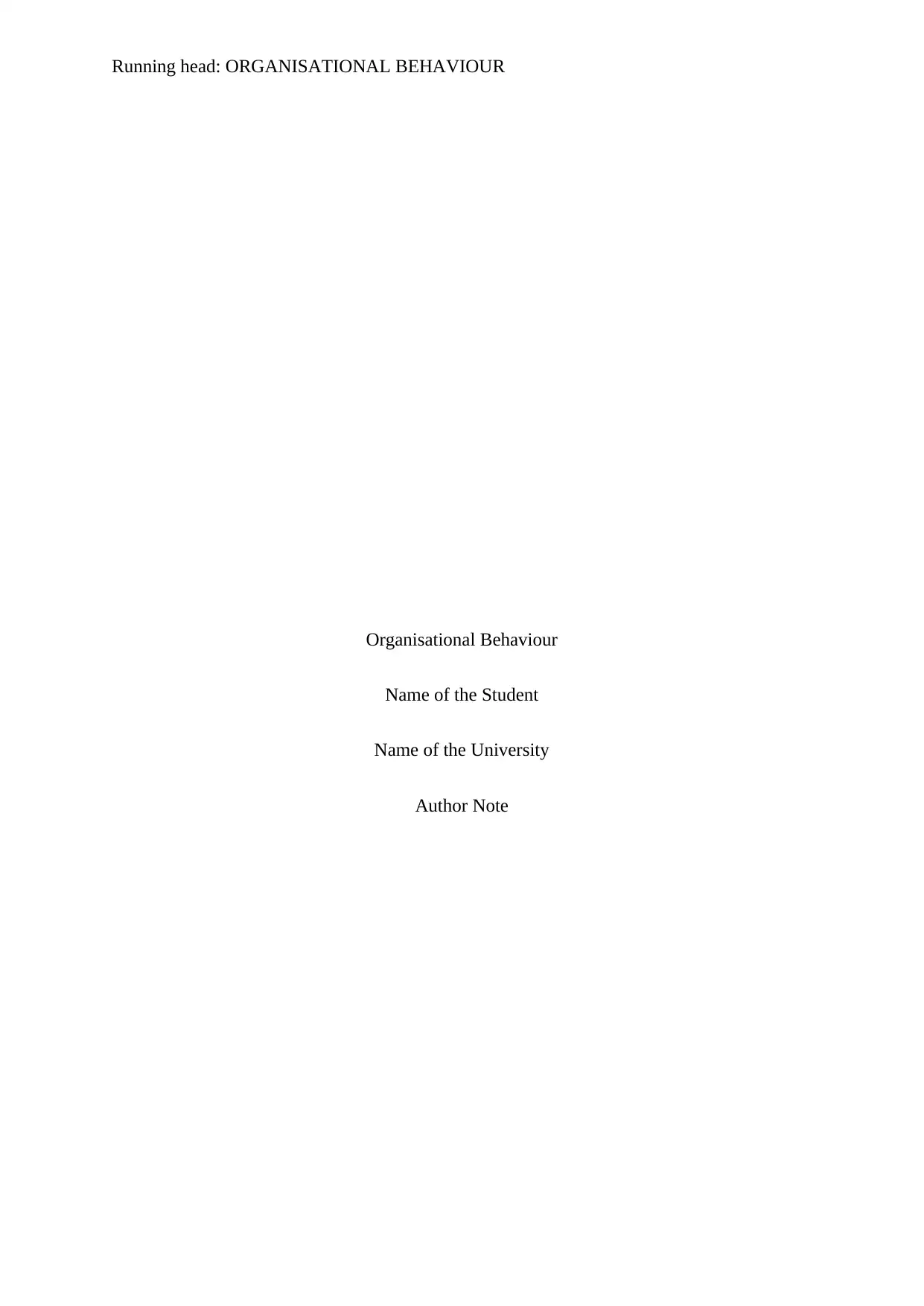
Running head: ORGANISATIONAL BEHAVIOUR
Organisational Behaviour
Name of the Student
Name of the University
Author Note
Organisational Behaviour
Name of the Student
Name of the University
Author Note
Paraphrase This Document
Need a fresh take? Get an instant paraphrase of this document with our AI Paraphraser
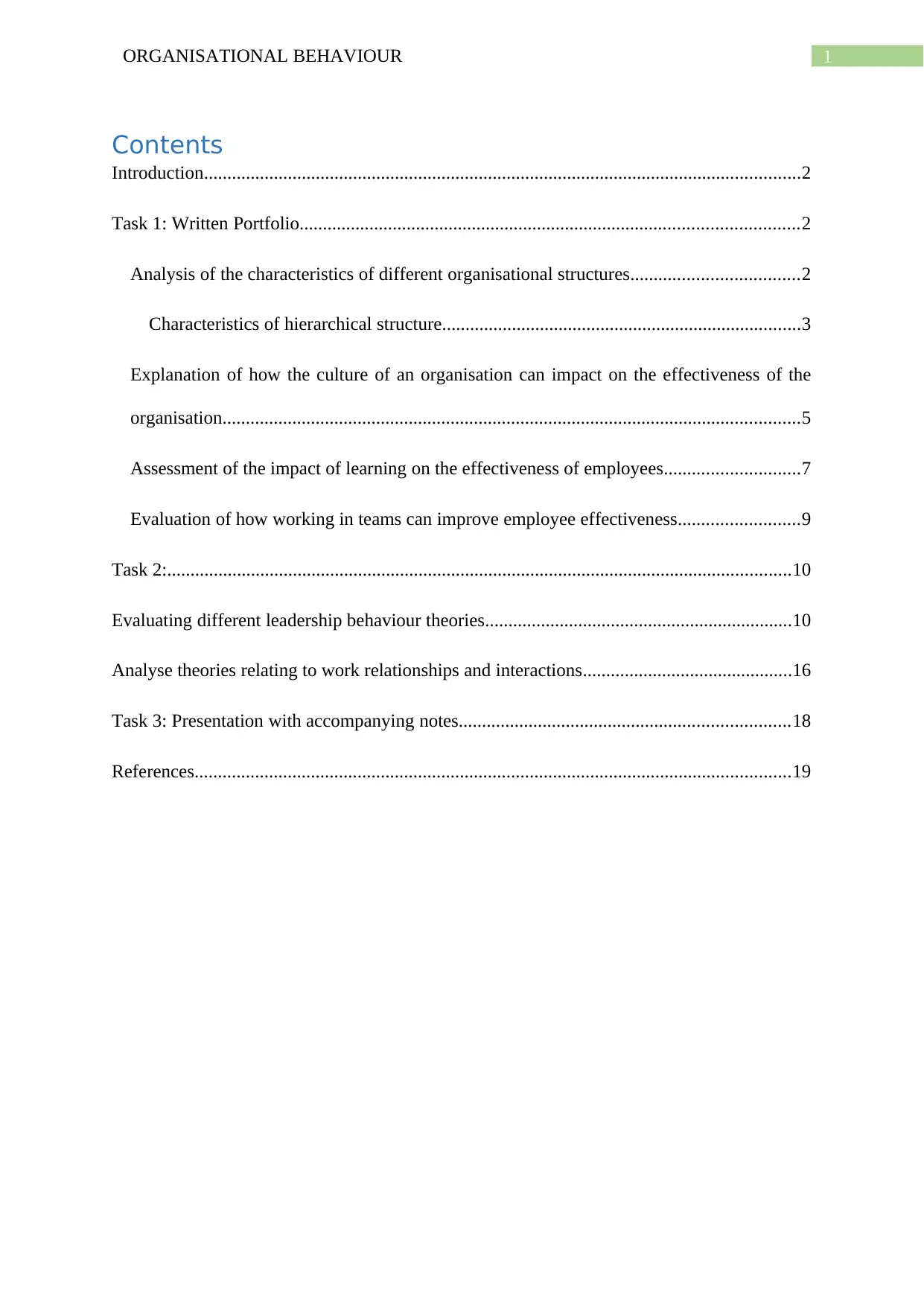
1ORGANISATIONAL BEHAVIOUR
Contents
Introduction................................................................................................................................2
Task 1: Written Portfolio...........................................................................................................2
Analysis of the characteristics of different organisational structures....................................2
Characteristics of hierarchical structure.............................................................................3
Explanation of how the culture of an organisation can impact on the effectiveness of the
organisation............................................................................................................................5
Assessment of the impact of learning on the effectiveness of employees.............................7
Evaluation of how working in teams can improve employee effectiveness..........................9
Task 2:......................................................................................................................................10
Evaluating different leadership behaviour theories..................................................................10
Analyse theories relating to work relationships and interactions.............................................16
Task 3: Presentation with accompanying notes.......................................................................18
References................................................................................................................................19
Contents
Introduction................................................................................................................................2
Task 1: Written Portfolio...........................................................................................................2
Analysis of the characteristics of different organisational structures....................................2
Characteristics of hierarchical structure.............................................................................3
Explanation of how the culture of an organisation can impact on the effectiveness of the
organisation............................................................................................................................5
Assessment of the impact of learning on the effectiveness of employees.............................7
Evaluation of how working in teams can improve employee effectiveness..........................9
Task 2:......................................................................................................................................10
Evaluating different leadership behaviour theories..................................................................10
Analyse theories relating to work relationships and interactions.............................................16
Task 3: Presentation with accompanying notes.......................................................................18
References................................................................................................................................19

2ORGANISATIONAL BEHAVIOUR
Introduction
This research report provides an in-depth detail about business management in the
contemporary business context. Business management is relatively a broad area in
management which covers several internal and external business elements. Organisations in
today’s contemporary business environment are most likely to face constant market threats.
Thereby, businesses today face a broad set of market dynamics that often drive the business.
Business in today’s changing business environment, needs to understand suitable planning,
strategy, finance and marketing. Likewise, there have been several internal elements that
often drive the business. This research report consists of three different parts and to develop
a suitable understanding about business development, first part of the report is more of
portfolio explaining organisational structure, organisational culture, employee-learning and
team-working.
Task 1: Written Portfolio
Analysis of the characteristics of different organisational structures
Having aligned with contemporary market requirements, there have been a number of
organisational structures mostly used by the businesses include hierarchical, matrix,
horizontal/flat structure, network structure, and divisional structure, line organisational
structure, team-based organisational structure, when it comes to hierarchical structure, it is
noted that hierarchical framework under which employees are grouped with every employee
and each employee tends to hold a clear supervisor (Mizutani et al. 2015).
Introduction
This research report provides an in-depth detail about business management in the
contemporary business context. Business management is relatively a broad area in
management which covers several internal and external business elements. Organisations in
today’s contemporary business environment are most likely to face constant market threats.
Thereby, businesses today face a broad set of market dynamics that often drive the business.
Business in today’s changing business environment, needs to understand suitable planning,
strategy, finance and marketing. Likewise, there have been several internal elements that
often drive the business. This research report consists of three different parts and to develop
a suitable understanding about business development, first part of the report is more of
portfolio explaining organisational structure, organisational culture, employee-learning and
team-working.
Task 1: Written Portfolio
Analysis of the characteristics of different organisational structures
Having aligned with contemporary market requirements, there have been a number of
organisational structures mostly used by the businesses include hierarchical, matrix,
horizontal/flat structure, network structure, and divisional structure, line organisational
structure, team-based organisational structure, when it comes to hierarchical structure, it is
noted that hierarchical framework under which employees are grouped with every employee
and each employee tends to hold a clear supervisor (Mizutani et al. 2015).
⊘ This is a preview!⊘
Do you want full access?
Subscribe today to unlock all pages.

Trusted by 1+ million students worldwide
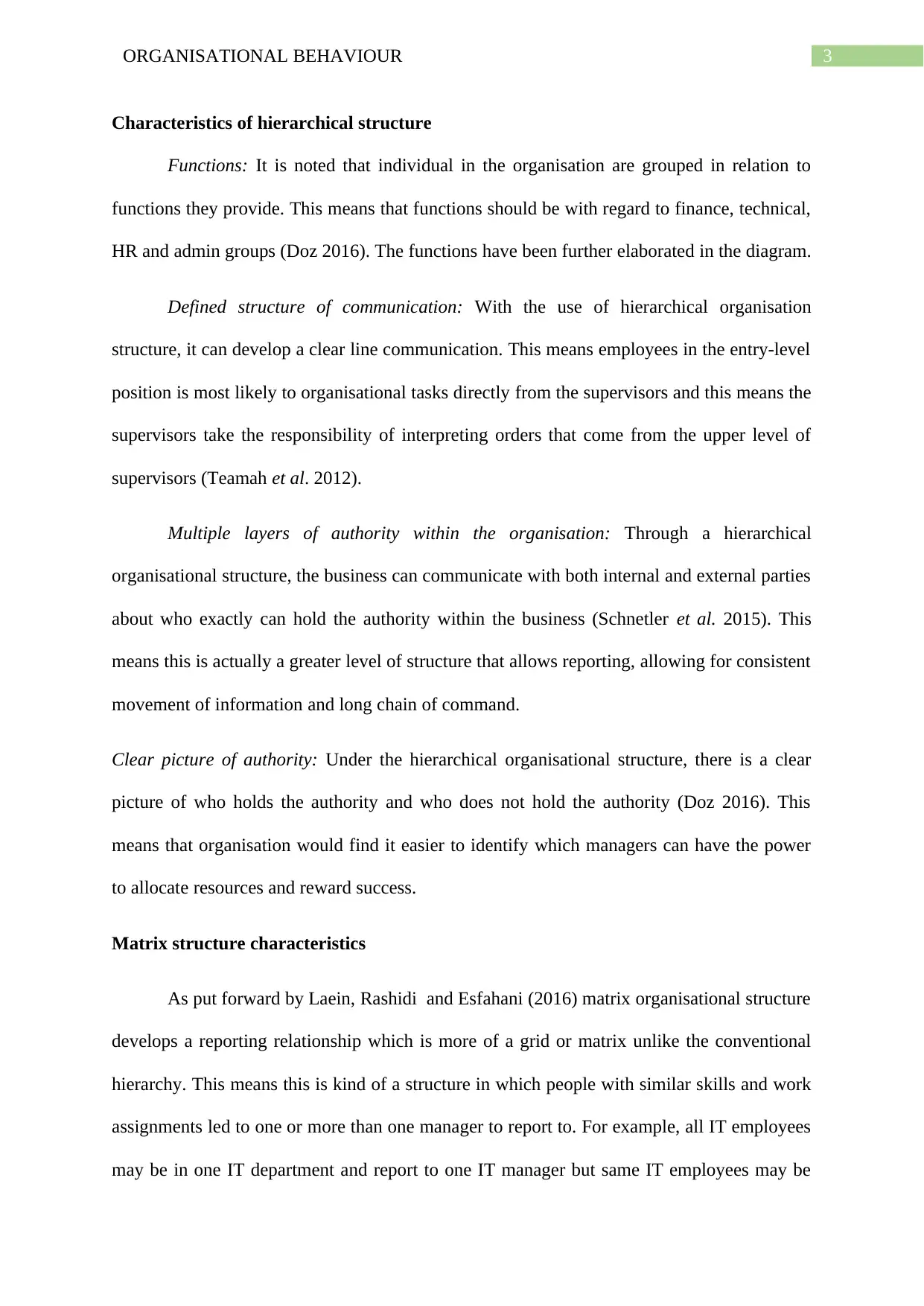
3ORGANISATIONAL BEHAVIOUR
Characteristics of hierarchical structure
Functions: It is noted that individual in the organisation are grouped in relation to
functions they provide. This means that functions should be with regard to finance, technical,
HR and admin groups (Doz 2016). The functions have been further elaborated in the diagram.
Defined structure of communication: With the use of hierarchical organisation
structure, it can develop a clear line communication. This means employees in the entry-level
position is most likely to organisational tasks directly from the supervisors and this means the
supervisors take the responsibility of interpreting orders that come from the upper level of
supervisors (Teamah et al. 2012).
Multiple layers of authority within the organisation: Through a hierarchical
organisational structure, the business can communicate with both internal and external parties
about who exactly can hold the authority within the business (Schnetler et al. 2015). This
means this is actually a greater level of structure that allows reporting, allowing for consistent
movement of information and long chain of command.
Clear picture of authority: Under the hierarchical organisational structure, there is a clear
picture of who holds the authority and who does not hold the authority (Doz 2016). This
means that organisation would find it easier to identify which managers can have the power
to allocate resources and reward success.
Matrix structure characteristics
As put forward by Laein, Rashidi and Esfahani (2016) matrix organisational structure
develops a reporting relationship which is more of a grid or matrix unlike the conventional
hierarchy. This means this is kind of a structure in which people with similar skills and work
assignments led to one or more than one manager to report to. For example, all IT employees
may be in one IT department and report to one IT manager but same IT employees may be
Characteristics of hierarchical structure
Functions: It is noted that individual in the organisation are grouped in relation to
functions they provide. This means that functions should be with regard to finance, technical,
HR and admin groups (Doz 2016). The functions have been further elaborated in the diagram.
Defined structure of communication: With the use of hierarchical organisation
structure, it can develop a clear line communication. This means employees in the entry-level
position is most likely to organisational tasks directly from the supervisors and this means the
supervisors take the responsibility of interpreting orders that come from the upper level of
supervisors (Teamah et al. 2012).
Multiple layers of authority within the organisation: Through a hierarchical
organisational structure, the business can communicate with both internal and external parties
about who exactly can hold the authority within the business (Schnetler et al. 2015). This
means this is actually a greater level of structure that allows reporting, allowing for consistent
movement of information and long chain of command.
Clear picture of authority: Under the hierarchical organisational structure, there is a clear
picture of who holds the authority and who does not hold the authority (Doz 2016). This
means that organisation would find it easier to identify which managers can have the power
to allocate resources and reward success.
Matrix structure characteristics
As put forward by Laein, Rashidi and Esfahani (2016) matrix organisational structure
develops a reporting relationship which is more of a grid or matrix unlike the conventional
hierarchy. This means this is kind of a structure in which people with similar skills and work
assignments led to one or more than one manager to report to. For example, all IT employees
may be in one IT department and report to one IT manager but same IT employees may be
Paraphrase This Document
Need a fresh take? Get an instant paraphrase of this document with our AI Paraphraser

4ORGANISATIONAL BEHAVIOUR
assigned to different projects. They might have to report to respective project managers of the
projects being done. Thus, some IT employees might have to work with multiple IT managers
in the job role (Teamah, Dawood and Shehata 2016). The major characteristics of matrix
structure is significantly characterized by having dual authority relationship power balance
particularly between functional and project manager.
Horizontal/flat structure characteristics
Horizontal or flat structure usually adopted by small or medium size firms and start-
ups firms in their initial or early stage. Mäkimattila, Saunila and Salminen (2014) argued that
large organisation would find it challenging to follow a horizontal or flat structure. The major
characteristic of flat organisational structure is that multiple levels of middle management are
omitted. The major advantage of this flat organisational structure is that flat structure enable
employees to make decisions quickly and independently which helps to speed up the process.
This means trained workforce can be productive by being involved in decision-making.
Network structure characteristics
It is noted that network organisational structure helps to visualise both external and
internal relationship between managers as well as top-level management. This structure is
less hierarchical but more decentralised and more flexible compared to other structure. As put
forward by Cosh, Fu and Hughes (2012), network structure remains within a social networks
and it fundamentally remains within open and communication reliable structure. It is noted
that network structure seems to be little agiler than other structure because it only has few
tires with extensive control and bottom flow of decision-making.
assigned to different projects. They might have to report to respective project managers of the
projects being done. Thus, some IT employees might have to work with multiple IT managers
in the job role (Teamah, Dawood and Shehata 2016). The major characteristics of matrix
structure is significantly characterized by having dual authority relationship power balance
particularly between functional and project manager.
Horizontal/flat structure characteristics
Horizontal or flat structure usually adopted by small or medium size firms and start-
ups firms in their initial or early stage. Mäkimattila, Saunila and Salminen (2014) argued that
large organisation would find it challenging to follow a horizontal or flat structure. The major
characteristic of flat organisational structure is that multiple levels of middle management are
omitted. The major advantage of this flat organisational structure is that flat structure enable
employees to make decisions quickly and independently which helps to speed up the process.
This means trained workforce can be productive by being involved in decision-making.
Network structure characteristics
It is noted that network organisational structure helps to visualise both external and
internal relationship between managers as well as top-level management. This structure is
less hierarchical but more decentralised and more flexible compared to other structure. As put
forward by Cosh, Fu and Hughes (2012), network structure remains within a social networks
and it fundamentally remains within open and communication reliable structure. It is noted
that network structure seems to be little agiler than other structure because it only has few
tires with extensive control and bottom flow of decision-making.
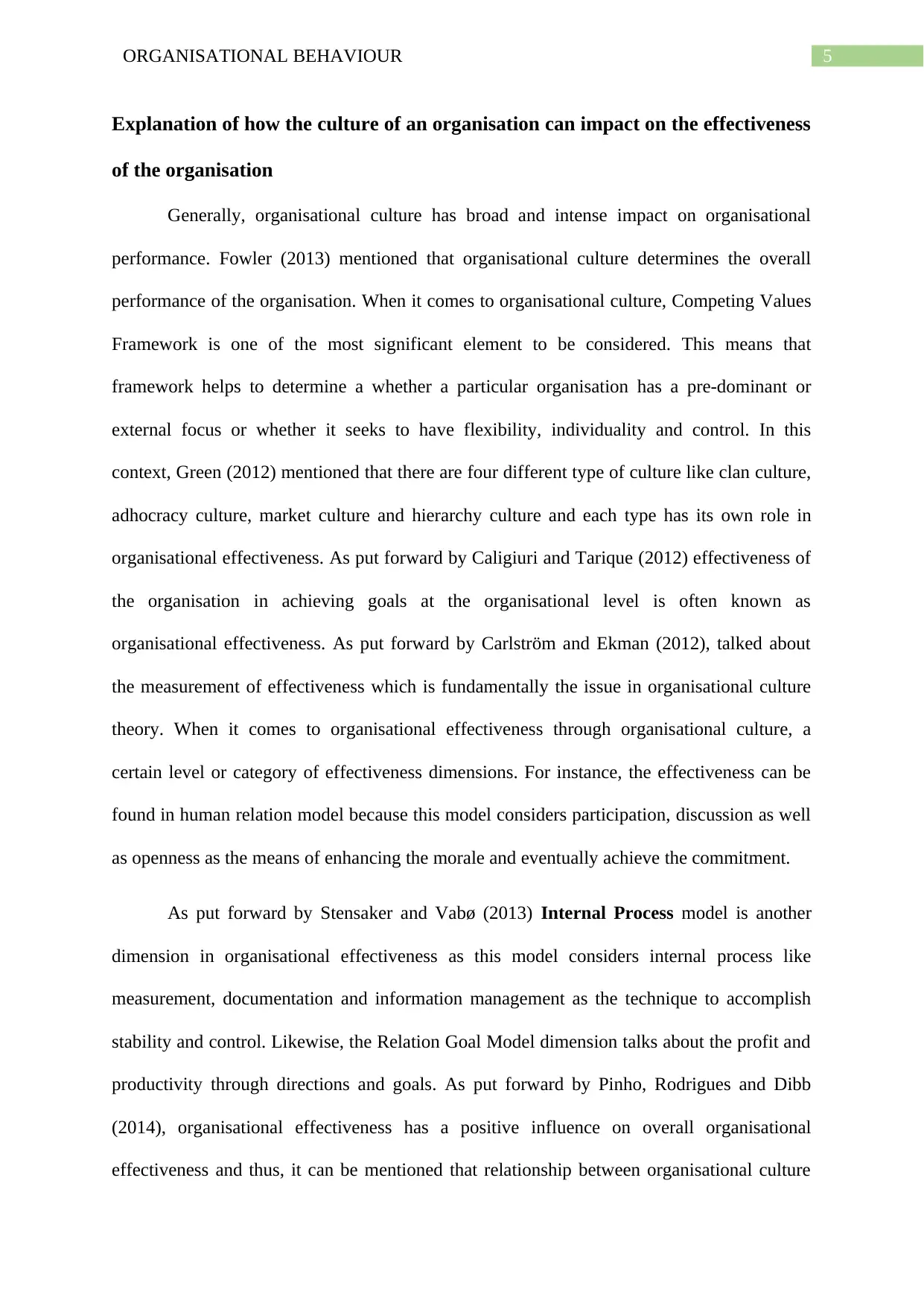
5ORGANISATIONAL BEHAVIOUR
Explanation of how the culture of an organisation can impact on the effectiveness
of the organisation
Generally, organisational culture has broad and intense impact on organisational
performance. Fowler (2013) mentioned that organisational culture determines the overall
performance of the organisation. When it comes to organisational culture, Competing Values
Framework is one of the most significant element to be considered. This means that
framework helps to determine a whether a particular organisation has a pre-dominant or
external focus or whether it seeks to have flexibility, individuality and control. In this
context, Green (2012) mentioned that there are four different type of culture like clan culture,
adhocracy culture, market culture and hierarchy culture and each type has its own role in
organisational effectiveness. As put forward by Caligiuri and Tarique (2012) effectiveness of
the organisation in achieving goals at the organisational level is often known as
organisational effectiveness. As put forward by Carlström and Ekman (2012), talked about
the measurement of effectiveness which is fundamentally the issue in organisational culture
theory. When it comes to organisational effectiveness through organisational culture, a
certain level or category of effectiveness dimensions. For instance, the effectiveness can be
found in human relation model because this model considers participation, discussion as well
as openness as the means of enhancing the morale and eventually achieve the commitment.
As put forward by Stensaker and Vabø (2013) Internal Process model is another
dimension in organisational effectiveness as this model considers internal process like
measurement, documentation and information management as the technique to accomplish
stability and control. Likewise, the Relation Goal Model dimension talks about the profit and
productivity through directions and goals. As put forward by Pinho, Rodrigues and Dibb
(2014), organisational effectiveness has a positive influence on overall organisational
effectiveness and thus, it can be mentioned that relationship between organisational culture
Explanation of how the culture of an organisation can impact on the effectiveness
of the organisation
Generally, organisational culture has broad and intense impact on organisational
performance. Fowler (2013) mentioned that organisational culture determines the overall
performance of the organisation. When it comes to organisational culture, Competing Values
Framework is one of the most significant element to be considered. This means that
framework helps to determine a whether a particular organisation has a pre-dominant or
external focus or whether it seeks to have flexibility, individuality and control. In this
context, Green (2012) mentioned that there are four different type of culture like clan culture,
adhocracy culture, market culture and hierarchy culture and each type has its own role in
organisational effectiveness. As put forward by Caligiuri and Tarique (2012) effectiveness of
the organisation in achieving goals at the organisational level is often known as
organisational effectiveness. As put forward by Carlström and Ekman (2012), talked about
the measurement of effectiveness which is fundamentally the issue in organisational culture
theory. When it comes to organisational effectiveness through organisational culture, a
certain level or category of effectiveness dimensions. For instance, the effectiveness can be
found in human relation model because this model considers participation, discussion as well
as openness as the means of enhancing the morale and eventually achieve the commitment.
As put forward by Stensaker and Vabø (2013) Internal Process model is another
dimension in organisational effectiveness as this model considers internal process like
measurement, documentation and information management as the technique to accomplish
stability and control. Likewise, the Relation Goal Model dimension talks about the profit and
productivity through directions and goals. As put forward by Pinho, Rodrigues and Dibb
(2014), organisational effectiveness has a positive influence on overall organisational
effectiveness and thus, it can be mentioned that relationship between organisational culture
⊘ This is a preview!⊘
Do you want full access?
Subscribe today to unlock all pages.

Trusted by 1+ million students worldwide
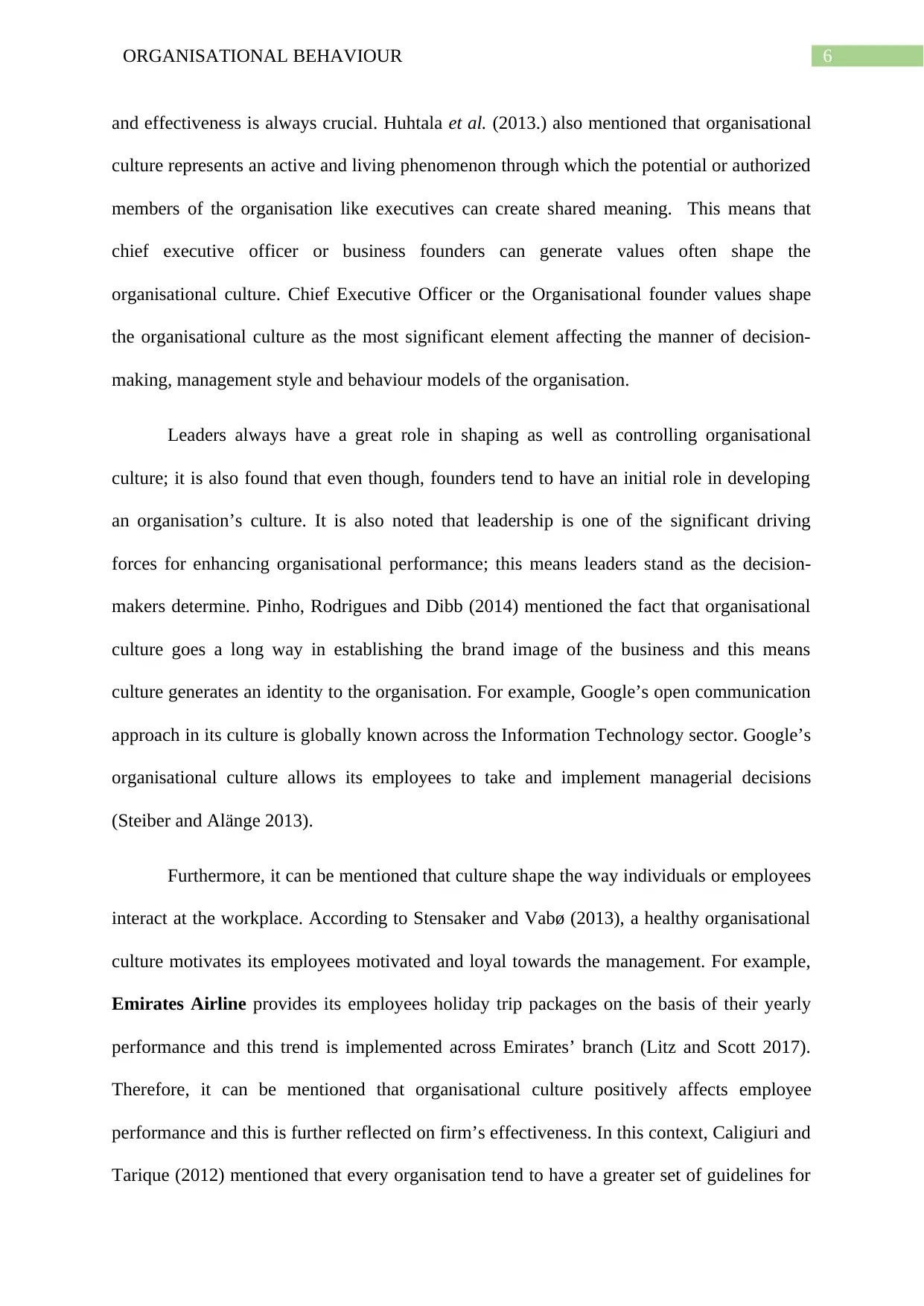
6ORGANISATIONAL BEHAVIOUR
and effectiveness is always crucial. Huhtala et al. (2013.) also mentioned that organisational
culture represents an active and living phenomenon through which the potential or authorized
members of the organisation like executives can create shared meaning. This means that
chief executive officer or business founders can generate values often shape the
organisational culture. Chief Executive Officer or the Organisational founder values shape
the organisational culture as the most significant element affecting the manner of decision-
making, management style and behaviour models of the organisation.
Leaders always have a great role in shaping as well as controlling organisational
culture; it is also found that even though, founders tend to have an initial role in developing
an organisation’s culture. It is also noted that leadership is one of the significant driving
forces for enhancing organisational performance; this means leaders stand as the decision-
makers determine. Pinho, Rodrigues and Dibb (2014) mentioned the fact that organisational
culture goes a long way in establishing the brand image of the business and this means
culture generates an identity to the organisation. For example, Google’s open communication
approach in its culture is globally known across the Information Technology sector. Google’s
organisational culture allows its employees to take and implement managerial decisions
(Steiber and Alänge 2013).
Furthermore, it can be mentioned that culture shape the way individuals or employees
interact at the workplace. According to Stensaker and Vabø (2013), a healthy organisational
culture motivates its employees motivated and loyal towards the management. For example,
Emirates Airline provides its employees holiday trip packages on the basis of their yearly
performance and this trend is implemented across Emirates’ branch (Litz and Scott 2017).
Therefore, it can be mentioned that organisational culture positively affects employee
performance and this is further reflected on firm’s effectiveness. In this context, Caligiuri and
Tarique (2012) mentioned that every organisation tend to have a greater set of guidelines for
and effectiveness is always crucial. Huhtala et al. (2013.) also mentioned that organisational
culture represents an active and living phenomenon through which the potential or authorized
members of the organisation like executives can create shared meaning. This means that
chief executive officer or business founders can generate values often shape the
organisational culture. Chief Executive Officer or the Organisational founder values shape
the organisational culture as the most significant element affecting the manner of decision-
making, management style and behaviour models of the organisation.
Leaders always have a great role in shaping as well as controlling organisational
culture; it is also found that even though, founders tend to have an initial role in developing
an organisation’s culture. It is also noted that leadership is one of the significant driving
forces for enhancing organisational performance; this means leaders stand as the decision-
makers determine. Pinho, Rodrigues and Dibb (2014) mentioned the fact that organisational
culture goes a long way in establishing the brand image of the business and this means
culture generates an identity to the organisation. For example, Google’s open communication
approach in its culture is globally known across the Information Technology sector. Google’s
organisational culture allows its employees to take and implement managerial decisions
(Steiber and Alänge 2013).
Furthermore, it can be mentioned that culture shape the way individuals or employees
interact at the workplace. According to Stensaker and Vabø (2013), a healthy organisational
culture motivates its employees motivated and loyal towards the management. For example,
Emirates Airline provides its employees holiday trip packages on the basis of their yearly
performance and this trend is implemented across Emirates’ branch (Litz and Scott 2017).
Therefore, it can be mentioned that organisational culture positively affects employee
performance and this is further reflected on firm’s effectiveness. In this context, Caligiuri and
Tarique (2012) mentioned that every organisation tend to have a greater set of guidelines for
Paraphrase This Document
Need a fresh take? Get an instant paraphrase of this document with our AI Paraphraser

7ORGANISATIONAL BEHAVIOUR
individuals to wok accordingly. Therefore, it is worth stating that culture of the organisation
must represent specific set of predefined policies that can guide employees and provide them
a sense of direction at the workplace. An effective organisational culture can help the
organisation to derive a greater level of employee productivity. Furthermore, Carlström and
Ekman (2012) mentioned that if people feel represented by organisational culture, they are
certainly capable of developing a strong and positive relationship with the workplace. This
means if the employees gain the ability of performing or doing a great work if they identify
the values. Likewise, the organization can build trust in the organisation and this results in
higher level of employee retention.
Assessment of the impact of learning on the effectiveness of employees
It can be mentioned that learning has broad impact on the effectiveness of employees,
as learning especially covers training and development programs. As put forward by Elçi,
Şener, Aksoy and Alpkan (2012), training programs may involve significant or enormous
level of investment in relation to time and money. Thus, measuring the ‘Return on
Investment’ of training can become critical. Evaluating the effectiveness of corporate training
programs via scientifically validated technique is often called learning effectiveness. As put
forward by Manzoor (2012), a new innovation in the market often takes place each day and
accordingly given the intensely competitive nature of the market. Thereby, a new innovation
can be a significant reason that catalyse the changes in organisational goals and objectives of
the organisation. Likewise, the need for re-calibrating the skills of employees with respect to
competencies aligned with the business objectives.
Continuous often focus on learning and development program helps employees to
learn levelling up with the company’s expectation and providing existing employees with
supreme opportunity of expanding existing knowledge base (Navimipour and Zareie 2015).
With the increasing focus on continual learning and development, organisations are keen on
individuals to wok accordingly. Therefore, it is worth stating that culture of the organisation
must represent specific set of predefined policies that can guide employees and provide them
a sense of direction at the workplace. An effective organisational culture can help the
organisation to derive a greater level of employee productivity. Furthermore, Carlström and
Ekman (2012) mentioned that if people feel represented by organisational culture, they are
certainly capable of developing a strong and positive relationship with the workplace. This
means if the employees gain the ability of performing or doing a great work if they identify
the values. Likewise, the organization can build trust in the organisation and this results in
higher level of employee retention.
Assessment of the impact of learning on the effectiveness of employees
It can be mentioned that learning has broad impact on the effectiveness of employees,
as learning especially covers training and development programs. As put forward by Elçi,
Şener, Aksoy and Alpkan (2012), training programs may involve significant or enormous
level of investment in relation to time and money. Thus, measuring the ‘Return on
Investment’ of training can become critical. Evaluating the effectiveness of corporate training
programs via scientifically validated technique is often called learning effectiveness. As put
forward by Manzoor (2012), a new innovation in the market often takes place each day and
accordingly given the intensely competitive nature of the market. Thereby, a new innovation
can be a significant reason that catalyse the changes in organisational goals and objectives of
the organisation. Likewise, the need for re-calibrating the skills of employees with respect to
competencies aligned with the business objectives.
Continuous often focus on learning and development program helps employees to
learn levelling up with the company’s expectation and providing existing employees with
supreme opportunity of expanding existing knowledge base (Navimipour and Zareie 2015).
With the increasing focus on continual learning and development, organisations are keen on
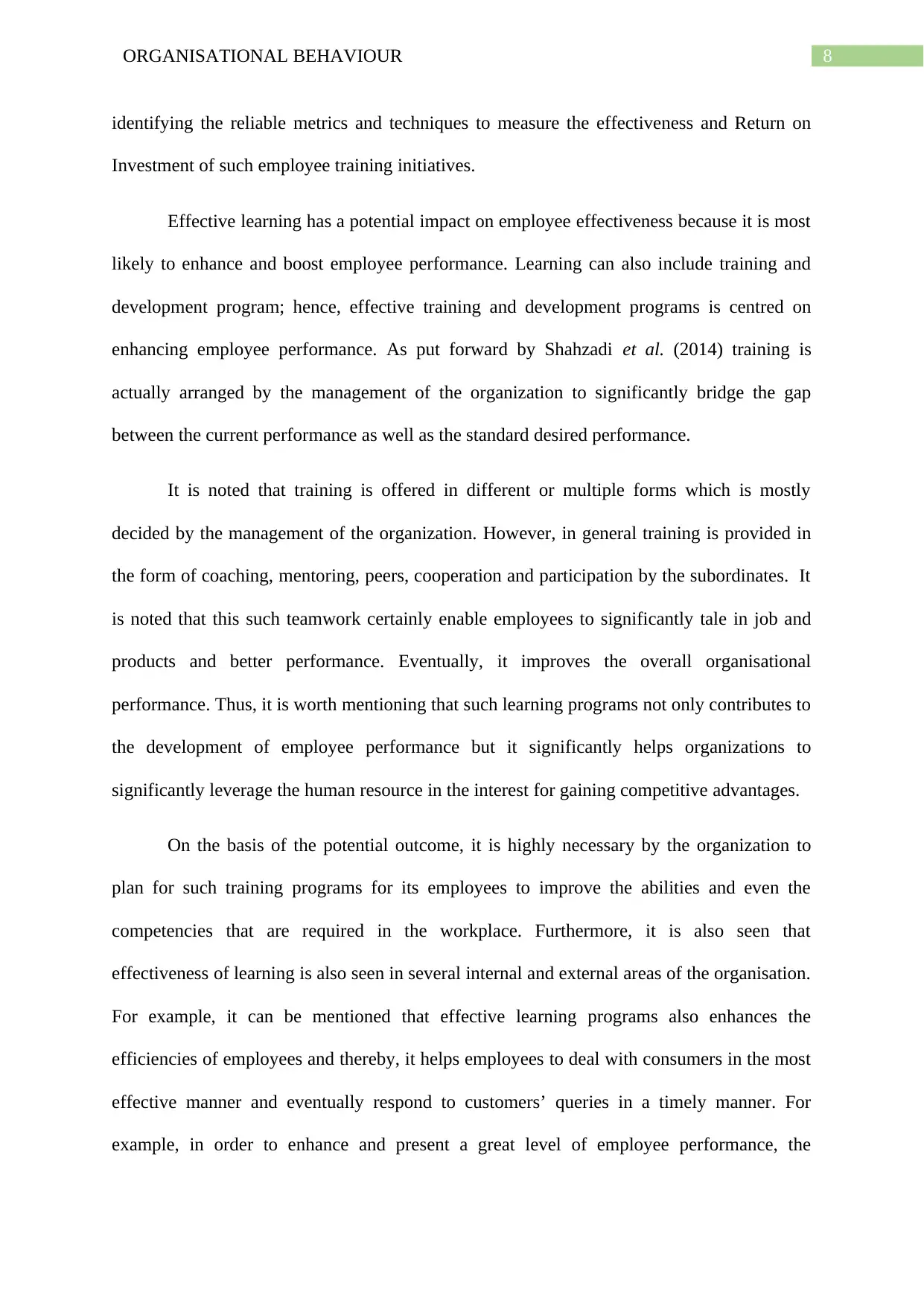
8ORGANISATIONAL BEHAVIOUR
identifying the reliable metrics and techniques to measure the effectiveness and Return on
Investment of such employee training initiatives.
Effective learning has a potential impact on employee effectiveness because it is most
likely to enhance and boost employee performance. Learning can also include training and
development program; hence, effective training and development programs is centred on
enhancing employee performance. As put forward by Shahzadi et al. (2014) training is
actually arranged by the management of the organization to significantly bridge the gap
between the current performance as well as the standard desired performance.
It is noted that training is offered in different or multiple forms which is mostly
decided by the management of the organization. However, in general training is provided in
the form of coaching, mentoring, peers, cooperation and participation by the subordinates. It
is noted that this such teamwork certainly enable employees to significantly tale in job and
products and better performance. Eventually, it improves the overall organisational
performance. Thus, it is worth mentioning that such learning programs not only contributes to
the development of employee performance but it significantly helps organizations to
significantly leverage the human resource in the interest for gaining competitive advantages.
On the basis of the potential outcome, it is highly necessary by the organization to
plan for such training programs for its employees to improve the abilities and even the
competencies that are required in the workplace. Furthermore, it is also seen that
effectiveness of learning is also seen in several internal and external areas of the organisation.
For example, it can be mentioned that effective learning programs also enhances the
efficiencies of employees and thereby, it helps employees to deal with consumers in the most
effective manner and eventually respond to customers’ queries in a timely manner. For
example, in order to enhance and present a great level of employee performance, the
identifying the reliable metrics and techniques to measure the effectiveness and Return on
Investment of such employee training initiatives.
Effective learning has a potential impact on employee effectiveness because it is most
likely to enhance and boost employee performance. Learning can also include training and
development program; hence, effective training and development programs is centred on
enhancing employee performance. As put forward by Shahzadi et al. (2014) training is
actually arranged by the management of the organization to significantly bridge the gap
between the current performance as well as the standard desired performance.
It is noted that training is offered in different or multiple forms which is mostly
decided by the management of the organization. However, in general training is provided in
the form of coaching, mentoring, peers, cooperation and participation by the subordinates. It
is noted that this such teamwork certainly enable employees to significantly tale in job and
products and better performance. Eventually, it improves the overall organisational
performance. Thus, it is worth mentioning that such learning programs not only contributes to
the development of employee performance but it significantly helps organizations to
significantly leverage the human resource in the interest for gaining competitive advantages.
On the basis of the potential outcome, it is highly necessary by the organization to
plan for such training programs for its employees to improve the abilities and even the
competencies that are required in the workplace. Furthermore, it is also seen that
effectiveness of learning is also seen in several internal and external areas of the organisation.
For example, it can be mentioned that effective learning programs also enhances the
efficiencies of employees and thereby, it helps employees to deal with consumers in the most
effective manner and eventually respond to customers’ queries in a timely manner. For
example, in order to enhance and present a great level of employee performance, the
⊘ This is a preview!⊘
Do you want full access?
Subscribe today to unlock all pages.

Trusted by 1+ million students worldwide
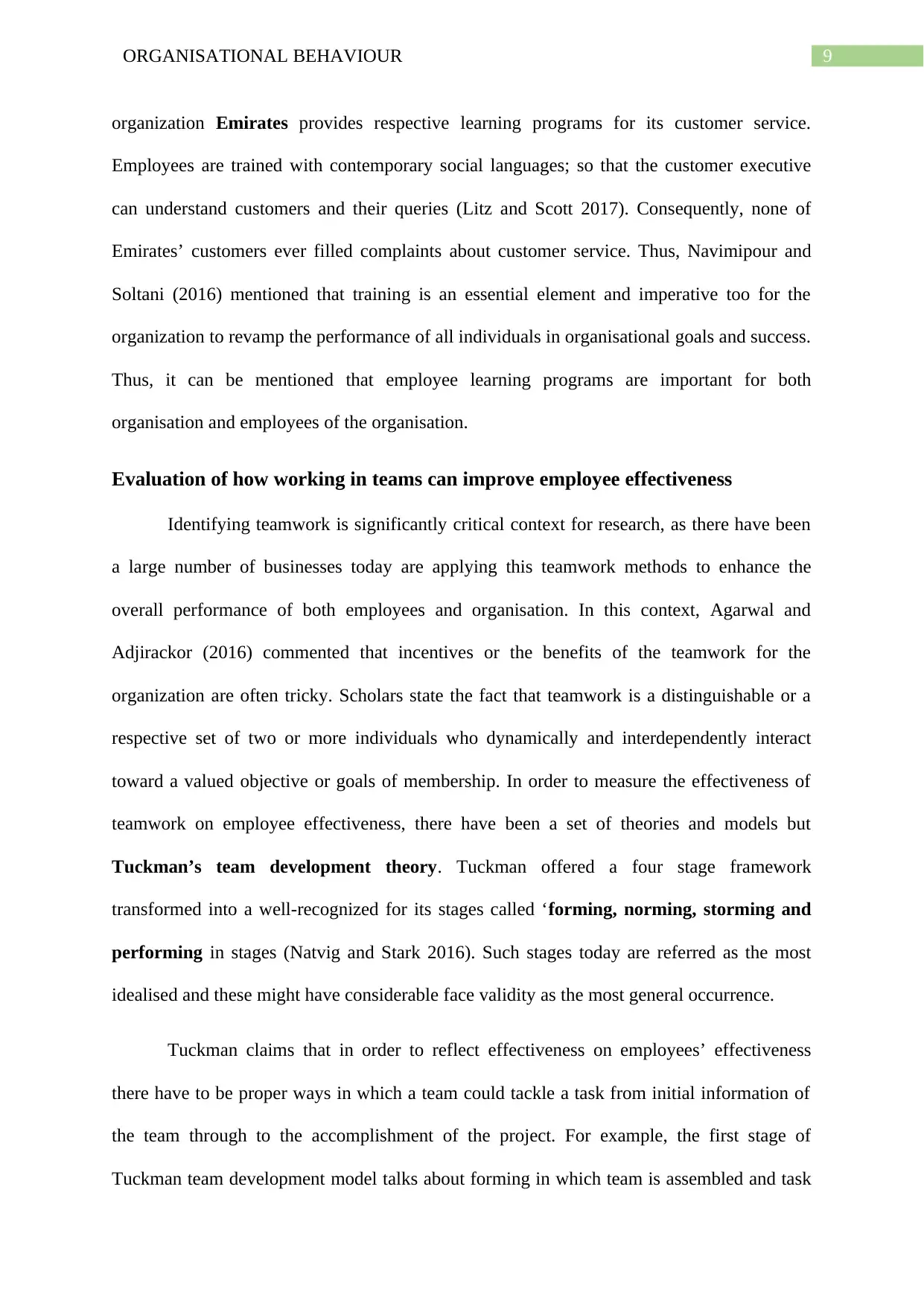
9ORGANISATIONAL BEHAVIOUR
organization Emirates provides respective learning programs for its customer service.
Employees are trained with contemporary social languages; so that the customer executive
can understand customers and their queries (Litz and Scott 2017). Consequently, none of
Emirates’ customers ever filled complaints about customer service. Thus, Navimipour and
Soltani (2016) mentioned that training is an essential element and imperative too for the
organization to revamp the performance of all individuals in organisational goals and success.
Thus, it can be mentioned that employee learning programs are important for both
organisation and employees of the organisation.
Evaluation of how working in teams can improve employee effectiveness
Identifying teamwork is significantly critical context for research, as there have been
a large number of businesses today are applying this teamwork methods to enhance the
overall performance of both employees and organisation. In this context, Agarwal and
Adjirackor (2016) commented that incentives or the benefits of the teamwork for the
organization are often tricky. Scholars state the fact that teamwork is a distinguishable or a
respective set of two or more individuals who dynamically and interdependently interact
toward a valued objective or goals of membership. In order to measure the effectiveness of
teamwork on employee effectiveness, there have been a set of theories and models but
Tuckman’s team development theory. Tuckman offered a four stage framework
transformed into a well-recognized for its stages called ‘forming, norming, storming and
performing in stages (Natvig and Stark 2016). Such stages today are referred as the most
idealised and these might have considerable face validity as the most general occurrence.
Tuckman claims that in order to reflect effectiveness on employees’ effectiveness
there have to be proper ways in which a team could tackle a task from initial information of
the team through to the accomplishment of the project. For example, the first stage of
Tuckman team development model talks about forming in which team is assembled and task
organization Emirates provides respective learning programs for its customer service.
Employees are trained with contemporary social languages; so that the customer executive
can understand customers and their queries (Litz and Scott 2017). Consequently, none of
Emirates’ customers ever filled complaints about customer service. Thus, Navimipour and
Soltani (2016) mentioned that training is an essential element and imperative too for the
organization to revamp the performance of all individuals in organisational goals and success.
Thus, it can be mentioned that employee learning programs are important for both
organisation and employees of the organisation.
Evaluation of how working in teams can improve employee effectiveness
Identifying teamwork is significantly critical context for research, as there have been
a large number of businesses today are applying this teamwork methods to enhance the
overall performance of both employees and organisation. In this context, Agarwal and
Adjirackor (2016) commented that incentives or the benefits of the teamwork for the
organization are often tricky. Scholars state the fact that teamwork is a distinguishable or a
respective set of two or more individuals who dynamically and interdependently interact
toward a valued objective or goals of membership. In order to measure the effectiveness of
teamwork on employee effectiveness, there have been a set of theories and models but
Tuckman’s team development theory. Tuckman offered a four stage framework
transformed into a well-recognized for its stages called ‘forming, norming, storming and
performing in stages (Natvig and Stark 2016). Such stages today are referred as the most
idealised and these might have considerable face validity as the most general occurrence.
Tuckman claims that in order to reflect effectiveness on employees’ effectiveness
there have to be proper ways in which a team could tackle a task from initial information of
the team through to the accomplishment of the project. For example, the first stage of
Tuckman team development model talks about forming in which team is assembled and task
Paraphrase This Document
Need a fresh take? Get an instant paraphrase of this document with our AI Paraphraser
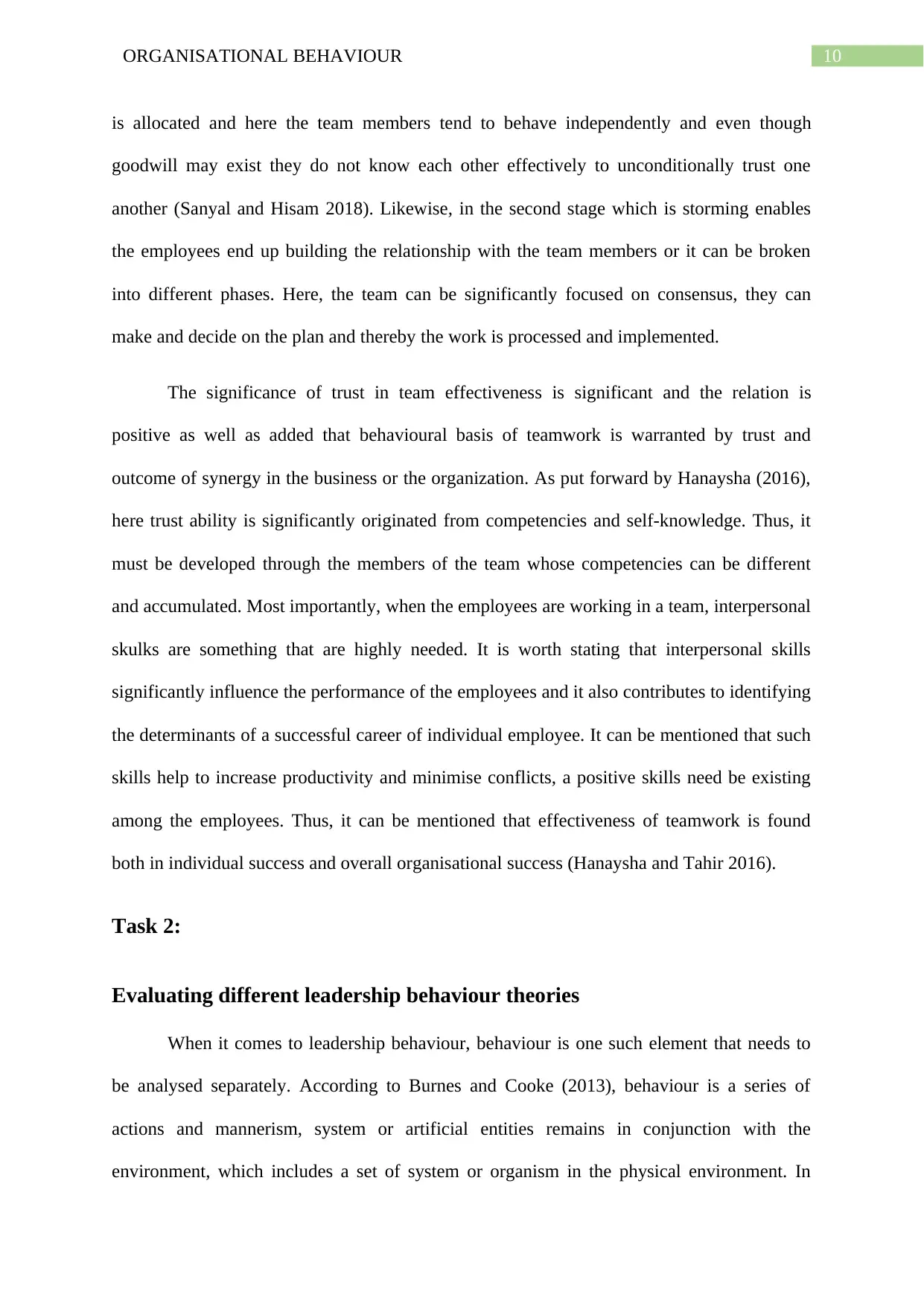
10ORGANISATIONAL BEHAVIOUR
is allocated and here the team members tend to behave independently and even though
goodwill may exist they do not know each other effectively to unconditionally trust one
another (Sanyal and Hisam 2018). Likewise, in the second stage which is storming enables
the employees end up building the relationship with the team members or it can be broken
into different phases. Here, the team can be significantly focused on consensus, they can
make and decide on the plan and thereby the work is processed and implemented.
The significance of trust in team effectiveness is significant and the relation is
positive as well as added that behavioural basis of teamwork is warranted by trust and
outcome of synergy in the business or the organization. As put forward by Hanaysha (2016),
here trust ability is significantly originated from competencies and self-knowledge. Thus, it
must be developed through the members of the team whose competencies can be different
and accumulated. Most importantly, when the employees are working in a team, interpersonal
skulks are something that are highly needed. It is worth stating that interpersonal skills
significantly influence the performance of the employees and it also contributes to identifying
the determinants of a successful career of individual employee. It can be mentioned that such
skills help to increase productivity and minimise conflicts, a positive skills need be existing
among the employees. Thus, it can be mentioned that effectiveness of teamwork is found
both in individual success and overall organisational success (Hanaysha and Tahir 2016).
Task 2:
Evaluating different leadership behaviour theories
When it comes to leadership behaviour, behaviour is one such element that needs to
be analysed separately. According to Burnes and Cooke (2013), behaviour is a series of
actions and mannerism, system or artificial entities remains in conjunction with the
environment, which includes a set of system or organism in the physical environment. In
is allocated and here the team members tend to behave independently and even though
goodwill may exist they do not know each other effectively to unconditionally trust one
another (Sanyal and Hisam 2018). Likewise, in the second stage which is storming enables
the employees end up building the relationship with the team members or it can be broken
into different phases. Here, the team can be significantly focused on consensus, they can
make and decide on the plan and thereby the work is processed and implemented.
The significance of trust in team effectiveness is significant and the relation is
positive as well as added that behavioural basis of teamwork is warranted by trust and
outcome of synergy in the business or the organization. As put forward by Hanaysha (2016),
here trust ability is significantly originated from competencies and self-knowledge. Thus, it
must be developed through the members of the team whose competencies can be different
and accumulated. Most importantly, when the employees are working in a team, interpersonal
skulks are something that are highly needed. It is worth stating that interpersonal skills
significantly influence the performance of the employees and it also contributes to identifying
the determinants of a successful career of individual employee. It can be mentioned that such
skills help to increase productivity and minimise conflicts, a positive skills need be existing
among the employees. Thus, it can be mentioned that effectiveness of teamwork is found
both in individual success and overall organisational success (Hanaysha and Tahir 2016).
Task 2:
Evaluating different leadership behaviour theories
When it comes to leadership behaviour, behaviour is one such element that needs to
be analysed separately. According to Burnes and Cooke (2013), behaviour is a series of
actions and mannerism, system or artificial entities remains in conjunction with the
environment, which includes a set of system or organism in the physical environment. In
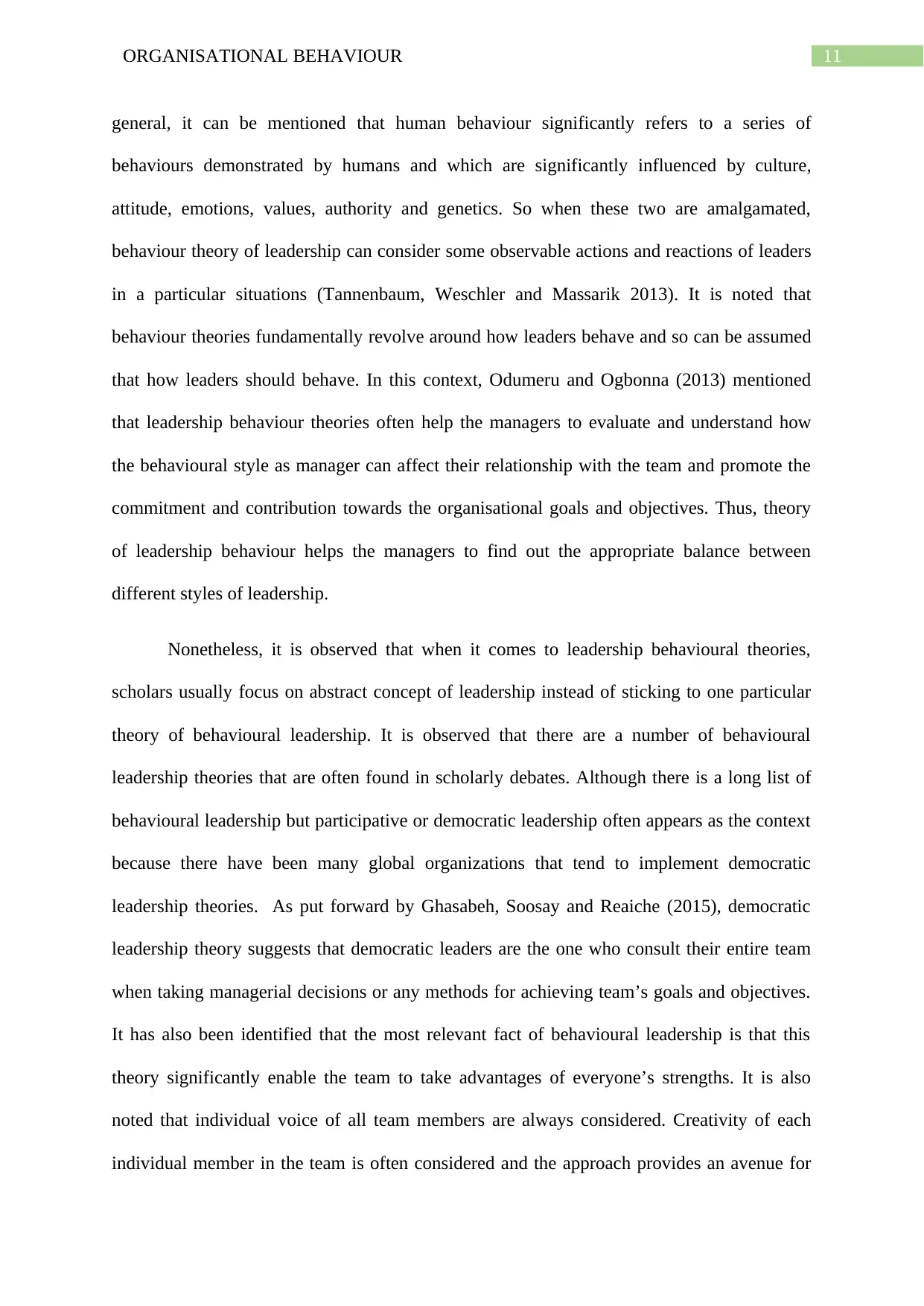
11ORGANISATIONAL BEHAVIOUR
general, it can be mentioned that human behaviour significantly refers to a series of
behaviours demonstrated by humans and which are significantly influenced by culture,
attitude, emotions, values, authority and genetics. So when these two are amalgamated,
behaviour theory of leadership can consider some observable actions and reactions of leaders
in a particular situations (Tannenbaum, Weschler and Massarik 2013). It is noted that
behaviour theories fundamentally revolve around how leaders behave and so can be assumed
that how leaders should behave. In this context, Odumeru and Ogbonna (2013) mentioned
that leadership behaviour theories often help the managers to evaluate and understand how
the behavioural style as manager can affect their relationship with the team and promote the
commitment and contribution towards the organisational goals and objectives. Thus, theory
of leadership behaviour helps the managers to find out the appropriate balance between
different styles of leadership.
Nonetheless, it is observed that when it comes to leadership behavioural theories,
scholars usually focus on abstract concept of leadership instead of sticking to one particular
theory of behavioural leadership. It is observed that there are a number of behavioural
leadership theories that are often found in scholarly debates. Although there is a long list of
behavioural leadership but participative or democratic leadership often appears as the context
because there have been many global organizations that tend to implement democratic
leadership theories. As put forward by Ghasabeh, Soosay and Reaiche (2015), democratic
leadership theory suggests that democratic leaders are the one who consult their entire team
when taking managerial decisions or any methods for achieving team’s goals and objectives.
It has also been identified that the most relevant fact of behavioural leadership is that this
theory significantly enable the team to take advantages of everyone’s strengths. It is also
noted that individual voice of all team members are always considered. Creativity of each
individual member in the team is often considered and the approach provides an avenue for
general, it can be mentioned that human behaviour significantly refers to a series of
behaviours demonstrated by humans and which are significantly influenced by culture,
attitude, emotions, values, authority and genetics. So when these two are amalgamated,
behaviour theory of leadership can consider some observable actions and reactions of leaders
in a particular situations (Tannenbaum, Weschler and Massarik 2013). It is noted that
behaviour theories fundamentally revolve around how leaders behave and so can be assumed
that how leaders should behave. In this context, Odumeru and Ogbonna (2013) mentioned
that leadership behaviour theories often help the managers to evaluate and understand how
the behavioural style as manager can affect their relationship with the team and promote the
commitment and contribution towards the organisational goals and objectives. Thus, theory
of leadership behaviour helps the managers to find out the appropriate balance between
different styles of leadership.
Nonetheless, it is observed that when it comes to leadership behavioural theories,
scholars usually focus on abstract concept of leadership instead of sticking to one particular
theory of behavioural leadership. It is observed that there are a number of behavioural
leadership theories that are often found in scholarly debates. Although there is a long list of
behavioural leadership but participative or democratic leadership often appears as the context
because there have been many global organizations that tend to implement democratic
leadership theories. As put forward by Ghasabeh, Soosay and Reaiche (2015), democratic
leadership theory suggests that democratic leaders are the one who consult their entire team
when taking managerial decisions or any methods for achieving team’s goals and objectives.
It has also been identified that the most relevant fact of behavioural leadership is that this
theory significantly enable the team to take advantages of everyone’s strengths. It is also
noted that individual voice of all team members are always considered. Creativity of each
individual member in the team is often considered and the approach provides an avenue for
⊘ This is a preview!⊘
Do you want full access?
Subscribe today to unlock all pages.

Trusted by 1+ million students worldwide
1 out of 25